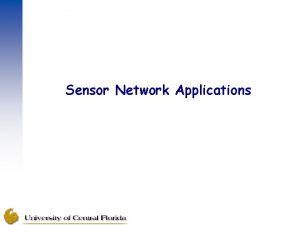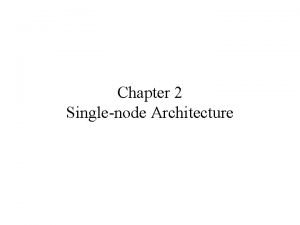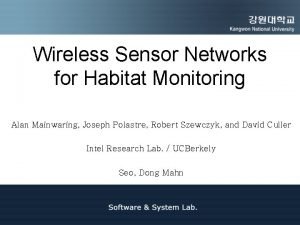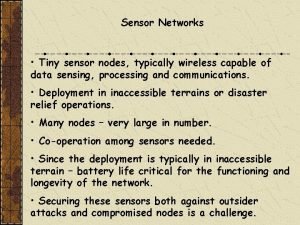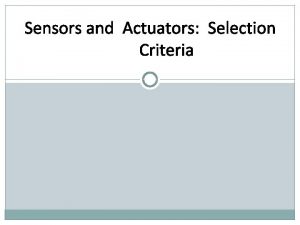Detecting Phantom Nodes in Wireless Sensor Networks n











- Slides: 11

Detecting Phantom Nodes in Wireless Sensor Networks n n n Joengmin Hwang Tian He Yongdae Kim Department of Computer Science, University of Minnesota, Minneapolis Infocom 2007 n Slides by Alex Papadimitriou

Detecting Phantom Nodes in Wireless Sensor Networks n n Security attacks become possible if malicious nodes could claim fake locations that are different from where they are physically located. Propose a secure localization mechanism that detects the existence of these nodes, phantom nodes. Most approaches depend on a few trusted entities (nodes or anchors), requiring at least the majority of these entities are not compromised. Based on a local map, a visual representation on the locations of neighbors of a node, which can be constructed correctly by verifying all location claims of its legitimate neighbors and filtering out phantom nodes generated by attacks.

Detecting Phantom Nodes in Wireless Sensor Networks n Benefits: 1. 2. 1. A node’s compromised decision does not propagate to affect other nodes’ decisions. Much less information exchange is required leading to less energy consumption. Major Contributions: 1. 2. 3. Two rules to prevent phantom nodes generating consistent ranging claims. The approach recovers a local map agreed by the majority of consistent information. The approach can use any ranging technique, not specially requiring distance bounding technique for location verification.

Detecting Phantom Nodes in Wireless Sensor Networks n Assumptions: 1. 2. 3. 1. 2. Bidirectional channels Reasonable network density Two dimensions The design only allows a node to claim about its distances to other neighboring nodes, not its own location. Therefore the phantom node needs to fake a set of distances to all of its neighboring nodes. Without the location information of the neighboring nodes, it is hard for an attacker to generate a set of consistent ranging values, and hence to fake itself into a different physical location.

Detecting Phantom Nodes in Wireless Sensor Networks Fig. 1 a: attacker D at the location p obtains three ranging distances in the 2 -D space from three honest nodes A, B and C. It can only conclude that A, B and C are located at the edges of three concentric circles centered at p. To claim a different physical location p′ within the 2 -D space, the attacker D needs to fake three different ranging distances that are consistent n Two rules: 1. 2. Accepting only ranging claims, not location claims. Hiding the location information during the ranging phase.

Detecting Phantom Nodes in Wireless Sensor Networks As shown in Figure 1 a, to move from the position p to p′, the attacker D needs to claim two shorter ranging distances to Nodes B and C, but a longer ranging distance to Node A; However in case of Figure 1 b, the attacker D needs to claim the opposite. Since the locations of A, B and C are unknown, the attacker cannot decide which claim to make. n We note that a sensor network normally has a high node density (>>10), which makes a consistent ranging claim practically impossible without the neighbors’ location information.

Detecting Phantom Nodes in Wireless Sensor Networks n n A set of nodes is consistent if they can be projected on the unique Euclidean plane, keeping the measured distances among themselves. Two main phases: distance measurement phase and filtering phase. In the first phase, each node measures the distances to its neighbors. In the second phase, each node projects its neighboring nodes to a virtual local plane to determine the largest consistent subset of nodes. After the completion of the two phases, each node establishes a local view without phantom nodes.

Detecting Phantom Nodes in Wireless Sensor Networks n 1. 2. 3. 4. n Distance measurement phase: Each node u measures the distances to neighbors and disseminates these measurements back to its neighbors. Node u first measures distance dui to each neighbor i. Node u then announces the measured distances. The announcement message includes id of the node u, id of the node I and distance measurement to i by u. Note that even when u knows about its location, it should not disclose it in this phase. When neighbor i announces its measured distance to its neighbor j, u collects dij. U collects neighbors’ announcements on the measured distances to their neighbors. After collection, node u compares the data. For each collected distance, if dij = dji, it is included in the filtering phase. It is possible that an attacker holds the announcements before it collects all the ranging information, and then calculates the relative locations of the honest nodes. Consequently, this attacker could fake a set of consistent range claims. To prevent such type of attack, we require each node announces one distance at a time in a round robin fashion within the neighborhood. This can be achieved by using pairwise ranging techniques [15].

Detecting Phantom Nodes in Wireless Sensor Networks n Filtering phase: 1. Initially, the node v picks up two neighbors i and j randomly as pivots. Using the node v as the origin, the neighbors i and j and three distance information among v, i and j, the local coordinate system is constructed. In the node v’s coordinate system, we use a graph G(V, E) to construct a consistent subset. The update process of the graph G is as follows: The location of the neighbor k is determined on the local coordinate system L by trilateration [16] from three nodes v, i, j with measured distances dkv, dki and dkj. After projecting all the neighbors on L, the distance between the projected neighbors is compared with the measured distance. For any two nodes i and j the distance dij = |pi − pj | is calculated from the projected location on L. If |dij − dij | ≥ ε, the edge between i and j is not included in E. The largest connected set V that contains node v is regarded as the largest consistent subset in the speculative plane L. This filtering procedure is done iter times (iter is a key parameter discussed later), and the cluster with the largest size is chosen as a final result. 2. 3. 4. 5.

Detecting Phantom Nodes in Wireless Sensor Networks

Detecting Phantom Nodes in Wireless Sensor Networks
 Wireless sensor networks for habitat monitoring
Wireless sensor networks for habitat monitoring Single node architecture in wireless sensor networks
Single node architecture in wireless sensor networks Habitat monitoring sensor
Habitat monitoring sensor Describe the scada transport over llns with map-t
Describe the scada transport over llns with map-t Constrained nodes and constrained networks
Constrained nodes and constrained networks Constrained nodes and constrained networks
Constrained nodes and constrained networks Sst wireless
Sst wireless Wireless sensor network protocols
Wireless sensor network protocols Wireless sensor network ppt
Wireless sensor network ppt Forest geove
Forest geove Telecommunications the internet and wireless technology
Telecommunications the internet and wireless technology Bluetooth based smart sensor networks
Bluetooth based smart sensor networks
